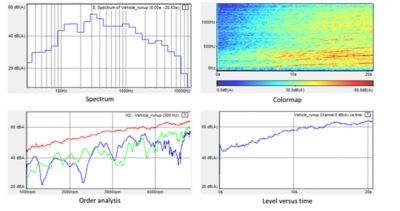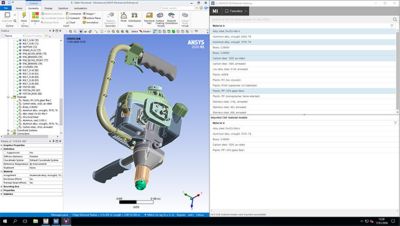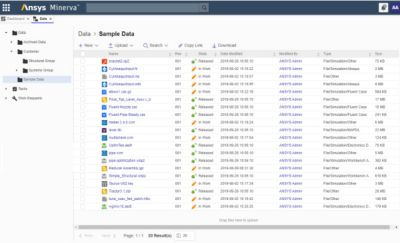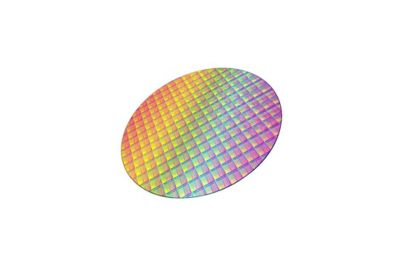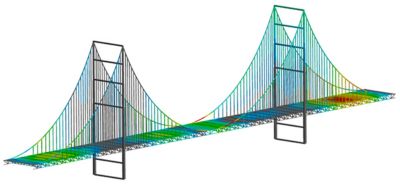Ansys Blog
January 28, 2020
Ansys 2020 R1 Helps Users Collaborate on Multiphysics Simulations
For instance, Ansys Minerva offers a platform that promotes collaboration, increases data sharing and supplies access to an array of physics-based simulation software.
Other improvements in Ansys 2020 R1 include:
For more Ansys 2020 R1 Product and Industry-Specific Overviews, Click Below:
- The Solver, Materials Data and Scan to CAD Improvements for Ansys 3D Design Tools
- Electromagnetic Updates for Autonomy, 5G, Electrification and Energy Applications
- Speed Up the Design and Generation of Embedded Software for Automotive and A&D Industries
- New Fluid Workflow Helps Users Solve Multiphase Simulations
- New Materials Data Management Tool Gets Simulation Teams on the Same Page
- Optical Simulation Improvements Increase Accuracy and CAD Integration
- Organizations Improve How They Handle Product Life Cycle Data with Ansys Minerva
- Semiconductor Power and Reliability Solutions for Complex Autonomous Driving, 5G and AI
- Streamlined Workflows that Can Assess Large Nonlinear Structures
- New Systems Simulation Tools to Simulate Light and Ensure Cybersecurity
The Solver, Materials Data and Scan to CAD Improvements for Ansys 3D Design Tools
在20万博20年的Ansys R1,Ansys Discovery Livegets updates to its structural and fluid solvers. These improvements enable users to study the strength of thin geometries and the flow of fluids at steady state.
ANSYS Discovery Live updates its structural and fluid solvers
Additionally, Discovery Live can now give users deep insights into manufacturing constraints and multi-analysis topology optimization.
Users interested in additive manufacturing and scanning objects into computer-aided design (CAD) geometry, will notice new features in Ansys Discovery SpaceClaim. For instance, users will be able to increase the efficiency of their printers by using minimal surface lattices. They can also combine analytic geometry with autoskinned patches while they scan a part.
Electromagnetic Updates for Autonomy, 5G, Electrification and Energy Applications
Ansys 2020 R1 improvements to theAnsys electromagnetic portfolio专注于帮助工程师设计和antenn的地方a and antenna arrays for autonomous vehicle, 5G, electrification and energy applications.
The ANSYS Maxwell harmonic force coupling feature
As an example, Ansys offers a solution for the analysis of antenna arrays that are used in diverse applications (such as 5G mmWave base stations and microcells). This technology, known as the 3D component domain decomposition method (3D Comp DDM), empowers engineers to efficiently solve large and complex antenna array problems.
Additional highlights include improvements that enableAnsys HFSS SBR+to assess creeping wave physics. This increases the accuracy of installed antenna analysis and placement studies when curved surfaces are involved.
Additionally, harmonic force coupling features inAnsys Maxwellwill enhance the vibroacoustic and electromagnetic design of electric vehicles, transformers, turbomachinery and more.
Other electromagnetic improvements in Ansys 2020 R1 include:
- The ability to assess and mitigate board- and package-level electromagnetic interference (EMI), without simulations, using EMI Xplorer withinAnsys SIwave
- The support of transient thermal analysis inAnsys Icepak
- The extension ofAnsys Cloudto include electrothermal simulations that involve Ansys Icepak
Speed Up the Design and Generation of Embedded Software for Automotive and A&D Industries
The Ansys 2020 R1 upgrades toAnsys SCADEsoftware speed up the design and automatic code generation of embedded control software. This embedded software, which is DO-178C certified and ISO 262626 ASIL D-compliant, can then be used to control vehicle components for the aerospace and defense (A&D) or automotive industry.
ANSYS SCADE makes it faster to design and generate
embedded control software for autonomous vehicles.
For instance, the release streamlines the design and workflow integration needed to create embedded software for avionic cockpit display systems that meet the ARINC 661 standard.
这些更新包括:
- Improvements to the user interface (UI) of Ansys SCADE that simplify the Simulink® importer for theSCADE Suitediff module
- New Ansys SCADE Suite features for multirate and multicore designs
- New interval checking inAnsys SCADE Test
- Faster robustness testing in Ansys SCADE Test
- Quicker detection methods of autonomous vehicle (AV) perception edge cases and fragilities inAnsys SCADE Vision
New Fluid Workflow Helps Users Solve Multiphase Simulations
Ansys 2020 R1 continues to make computational fluid dynamics (CFD) easy with new improvements to theAnsys Fluentuser experience. These improvements enable both experts and novices to use CFD simulations.
For instance, the newest workflow helps users set up multiphase simulations within a single, tabbed panel. In tests, the workflow walked users through the creation of gas‒liquid pipe flow simulations.
These users created the simulations 25% faster than they could before.
The Fluent algebraic interface area density (AIAD) model simulates
complex multiphase regime transitions — like air-water to
air-droplet flow in 180-degree pipe bends.
Fluent also has an algebraic interface area density (AIAD) model that can simulate transitions between continuous stratified flows and dispersed flows — like multiphase flows in a water pipe. This model is well suited to assess safety critical applications in:
- Nuclear reactors
- Oil and gas pipelines
- Steam generators
- Refrigeration equipment
- Reflux condensers
- Packed columns
- Heat pumps
The AIAD model can also be used with a third phase and mass transfer mechanisms to accurately simulate entrainment and absorption. It can also be combined with a population balance model to simulate bubbles and droplets.
Finally, a new immersive graphical user interface (GUI) for Fluent will enable users to interact directly with models and graphical elements. Users will be able to edit boundaries using popups that are accessed by clicking on the model.
Other CFD updates in Ansys 2020 R1 include:
- An electrochemistry model that optimizes lithium-ion battery cells
- AnAnsys CFXupgrade that doubles the speed of harmonic analyses that determine base frequencies
- A faster and easier method to set up two-way fluid-structure interaction (FSI) simulations
New Materials Data Management Tool Gets Simulation Teams on the Same Page
A cornerstone to any good simulation is the access to good materials data. That is why Ansys 2020 R1 includes an enhanced user experience forAnsys Granta MI Enterprisethat gives every employee of a large enterprise access to consistent, efficient and accurate materials information.
ANSYS GRANTA MI Pro gives engineering teams access to reliable
materials data within their regular computer-aided design (CAD)
and computer-aided engineering (CAE) tools
The release also includes a new product,Ansys Granta MI Pro. This focused version of Granta MI supports design and simulation teams with the ability to manage and apply in-house data alongside reliable materials reference data.
TheMaterials Data for Simulationdataset has also been updated and is available within Ansys Mechanical and Ansys Electronics Desktop.
Optical Simulation Improvements Increase Accuracy and CAD Integration
The Ansys 2020 R1 release ofAnsys Speosfocuses on increasing the speed and accuracy of optical simulations. For instance, the release enhances a texture-mapping feature that can realistically reproduce how materials look within an environment.
ANSYS Speos will have expanded sensor
simulation capabilities in ANSYS 2020 R1
CAD users will also be able to instantly update geometry within an optical simulation. These improved connections between Speos and CAD software will help boost productivity, optical simulation assessments and time to market.
Engineers working to deliver autonomous vehicles (AV) and advanced driver-assistance systems (ADAS) will also benefit from the expanded sensor simulation capabilities of Speos.
Other improvements to Speos include:
- Design features that account for manufacturing constraints that can cause downstream failures
- A new lens system importer to help engineers protect intellectual property
- Speos Live Preview support of camera sensors to predict the capture of raw footage
Organizations Improve How They Handle Product Life Cycle Data with Ansys Minerva
Ansys Minervais a platform that enables companies to organize product lifecycle data. For instance, companies can use it to:
- Collaborate
- Share/store/reuse data
- Visualize 3D models and simulations
A screenshot of ANSYS Minerva
这个平台也能够结合high-performance computing (HPC) systems and computer-aided engineering (CAE) tools.
在20万博20年的Ansys R1,Minerva will get numerous upgrades to its:
- Dashboards
- Configuration management
- Metadata management
- Ansys Workbenchclient connector
- Job submission workflow
- 万博optiSLangproject update functionality
Semiconductor Power and Reliability Solutions for Complex Autonomous Driving, 5G and AI
Trends like autonomous driving, 5G and artificial intelligence (AI) are increasing the demand to signoff ultra-large and high-performance system-on-chips (SoCs). As a result, Ansys 2020 R1 includes upgrades to Ansys’ semiconductor portfolio of power and reliability solutions that improve signoff coverage and time to market.
Key features for the automotive market include foundry certifications, multiphysics flows (including thermal and electronics reliability) and ISO 26262 certification of theAnsys RedHawk family,Ansys PowerArtistandAnsys Totem.
ANSYS 2020 R1 brings improvements to power and reliability
solutions within the ANSYS semiconductor portfolio
To maximize the potential for power savings, Ansys PowerArtist features static power efficiency checks that serve as early signoff criteria that can qualify register-transfer level (RTL) designs without requiring vectors. In addition, PowerArtist accelerates power profiling of emulator-generated application activity scenarios, reducing the risk of missing power-critical cycles.
The release adds new features for 5G semiconductor and electronics design, including 3D integrated circuit (3D-IC) and advanced process node support for Ansys RaptorX and Ansys RedHawk-SC.
Ansys RaptorX improves performance and capacity by over a factor of five. It also supports advanced layout dependent effects, complex packaging structures and stack-up scenarios.
Additionally, the new Ansys RedHawk-SC no-propagation vectorless (NPV) dynamic analysis software can identify power grid weaknesses in the absence of simulation vectors. It enables greater than 90% switching coverage to achieve increased signoff confidence. RedHawk-SC also includes advanced package simulation improvements for on-die power integrity analysis.
The Totem and Redhawk product families are certified to perform multiphysics signoff for a diverse number of fin field-effect transistor (FinFET) nodes down to 4nm/3nm and 2.5D/3D-IC packaging technologies.
Additionally, Totem features enhancements for power management integrated circuits (PMIC), which are critical for automotive, mobile and data center applications. Enhancements include improvement in performance, capacity and increased out-of-the-box accuracy for high current, high power devices. The runtime has improved by a factor of four to five while maintaining a memory footprint that is 20% to 40% of traditional finite-element method (FEM) solutions.
Streamlined Workflows that Can Assess Large Nonlinear Structures
Ansys Mechanicalis getting upgrades in Ansys 2020 R1 that improve its ability to process complex, highly nonlinear and massive models.
ANSYS Mechanical can process large,
complex, highly nonlinear models
AQWA,水动力分析工具,现在完全migrated into Ansys Mechanical. As a result, users have the ability to model liquid filled internal tanks and transfer the loads they generate to other analysis systems. This is ideal for those designing offshore systems. This new functionality is available on Linux and enables cluster-based solving.
Mechanical will also have a series of streamlined workflows that include:
- Enhanced interface integrations withLS-DYNA
- Cross sectional assignments for line bodies
- Post-processing of reinforcements
- Drag and drop of external models
Additionally, users will notice improvements to the topology optimization validation workflows that enable them to quickly get from a tessellated optimal shape to a mesh to a final design validation.
If users then wish to print these shapes, they can use Ansys Additive Prep to optimize the laser parameters of an additive manufacturing machine. They can then assess its inherent strain using Ansys Workbench Additive.
Other additive manufacturing improvements include:
- New printable materials that are compatible withAnsys Additive PrintandAdditive Science.
- New Additive Prep compatibility with EOS machines
As forAnsys Sherlock, it will have faster solve times because of the integration of MADPL as its default solver. Additionally, Sherlock now enables users to configure and manage multiple part libraries.
New Systems Simulation Tools to Simulate Light and Ensure Cybersecurity
Ansys 2020 R1 includes two new systems simulation solutions:Ansys VRXPERIENCE Light SimulationandAnsys medini analyze for cybersecurity.
VRXPERIENCE Light Simulation delivers engineering-grade light simulation to studio designers. The solution combines the functionality of Autodesk VRED’s design visualization software and Ansys’ physics-based lighting simulations. This enables users to design and engineer photorealistic visualizations of a vehicle’s interior or exterior lighting.
ANSYS VRXPERIENCE Light Simulation
helps engineers design photorealistic
visualizations of a vehicle’s interior
and exterior lighting
As for Ansys medini analyze for cybersecurity, it gives users the ability to systematically analyze and assess security threats to their system designs. Users can then use the original offering —Ansys medini analyze——确保他们的系统符合新的safety of the intended functionality (SOTIF) standard. These tools will be a big part of assessing the safety and cybersecurity of autonomous systems early in their development.
The release also includes theAnsys Twin BuilderBattery Wizard that guides users through the virtual construction of battery cells, modules, models and parameters.
Any and all ANSYS, Inc. brand, product, service and feature names, logos and slogans such as Ansys CFX, Ansys Discovery Live, Ansys Discovery SpaceClaim, Ansys Electronics Desktop, Ansys Fluent, Ansys GRANTA MI, Ansys HFSS, Ansys Icepak, Ansys Maxwell, Ansys Mechanical, Ansys medini, Ansys Minerva, Ansys optiSLang, Ansys PowerArtist, Ansys RaptorX, Ansys RedHawk, Ansys RedHawk-SC, Ansys SCADE, Ansys SCADE Suite, Ansys SCADE Test, Ansys Sherlock, Ansys SIwave, Ansys Speos, Ansys Totem, Ansys Twin Builder, Ansys VRXPERIENCE and Ansys Workbench are registered trademarks or trademarks of ANSYS, Inc. or its subsidiaries in the United States or other countries.


